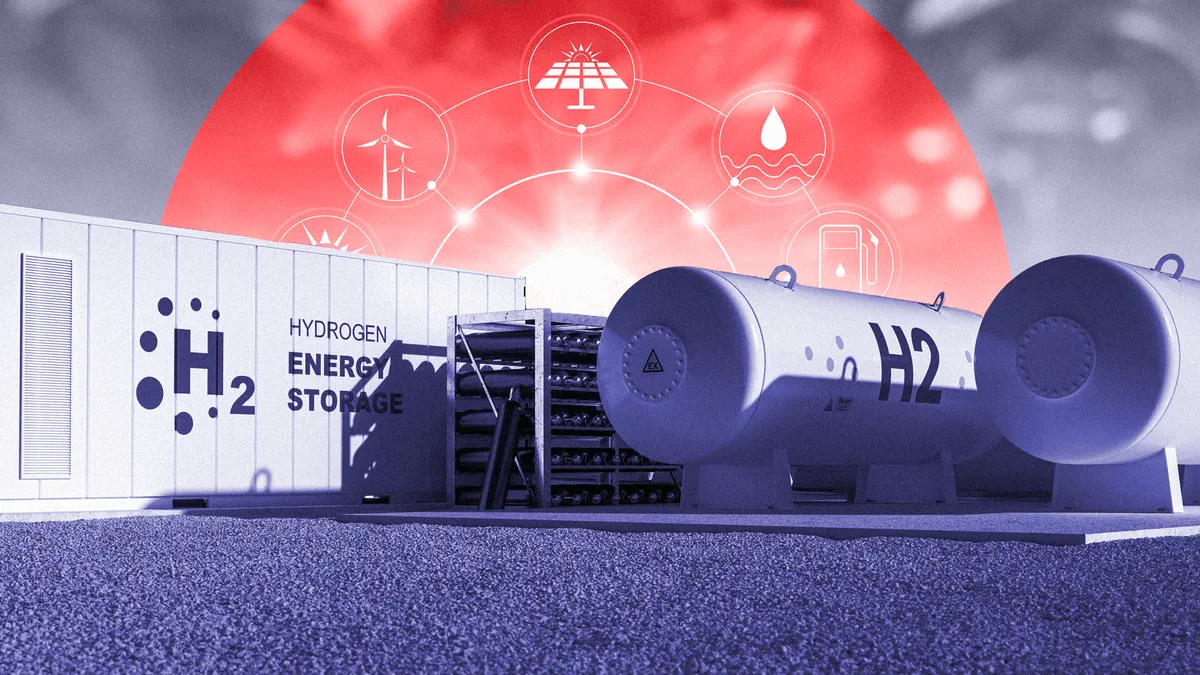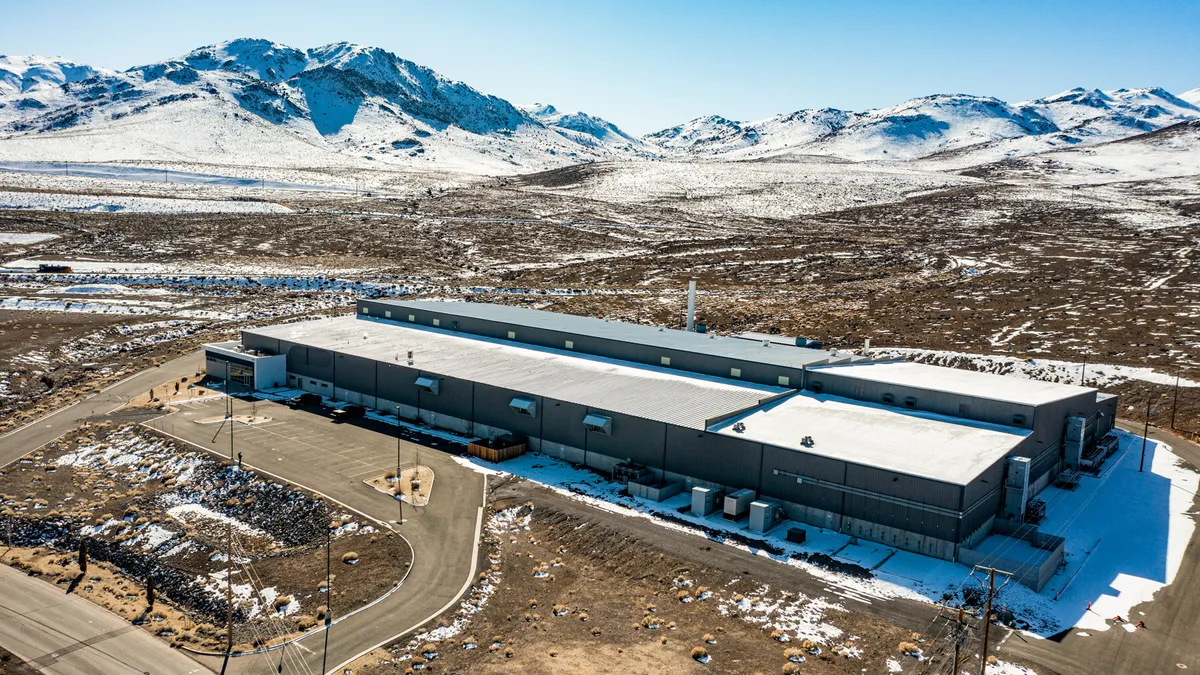As a new administration in Washington, D.C., drives a renewed interest in green hydrogen, and states like California research and invest in enabling technologies, experts say that Europe's experience could offer valuable lessons.
Experts see multiple ways in which green hydrogen — produced by powering an electrolyzer with renewable energy — could help drive the clean energy transition. It could use up excess renewables that would otherwise be curtailed, provide carbon-free electricity using fuel cells and decarbonize hard-to-electrify sectors. Hydrogen can also be stored for long periods of time, meaning it could serve as a form of seasonal energy storage.
In Europe, Germany began thinking through the multi-sectoral capabilities of hydrogen, and how to make it from renewable sources, years ago, according to Janice Lin, founder and president of the Green Hydrogen Coalition (GHC).
That work and other experiences from the E.U. could help inform the U.S. strategy to build out the green hydrogen sector, although domestic hydrogen development won't necessarily mimic that in Europe.
"There could be different motives, different drivers, different priority applications, different feedstocks and relative strengths," Lin added. "That flexibility to customize the solution for the needs and desires of the local population is essential."
'There's an objective underpinning'
At the moment, most U.S. hydrogen deployments are in the industrial sector, said Glenn McGrath, leader of the electricity statistics, uranium statistics and product innovation team at the U.S. Energy Information Administration. While the agency is seeing announcements of combined-cycle plants that say they can or will be able to burn hydrogen, "none of them have yet declared to us that hydrogen is a fuel for them," he explained.
One key challenge is there isn't currently a robust distribution network for hydrogen, according to McGrath.
"How does the hydrogen get around? Is it going to be trucked around? Are they going to modify natural gas pipelines to allow them to… transport hydrogen? Are they going to use a medium like ammonia?" he asked.
European players face similar questions, and they are still working out ways to answer them. Last year, the European Commission outlined its hydrogen strategy with a phased road map. During the first phase, through 2024, the focus is on scaling up the manufacturing of electrolyzers, to install a minimum of 6 GW worth of renewable hydrogen electrolyzers in the E.U. and produce up to 1 million metric tons of renewable hydrogen. Those figures increase to 40 GW of electrolyzers and 10 million metric tons of renewable hydrogen by 2030. In the third phase — 2030 onward — the hydrogen technologies should be deployed widely across hard-to-decarbonize sectors; by 2050, roughly a quarter of renewable electricity could go toward producing hydrogen, the road map states.
Individual countries have also announced their own hydrogen strategies, in most cases as a tool to meet carbon reduction initiatives, according to Thierry Lepercq, president and co-founder of green hydrogen developer DH2 Energy.
"If you compare it to the U.S., there is no such thing" as a hydrogen strategy to meet decarbonization goals, he added.
In the U.S., the hydrogen industry is "mostly focused on fuel cells, but not really looking at electrolysis — and by the way, if you don't have electrolysis, you don't have green hydrogen."

Thierry Lepercq
President and Co-Founder, DH2 Energy
Another area in which the E.U. is ahead of the U.S. is in electrolysis technology, Lepercq said. A lot of the market leaders in electrolysis are based in Europe, and the industry is moving aggressively with gigafactory announcements. In the U.S., however, the hydrogen industry is "mostly focused on fuel cells, but not really looking at electrolysis — and by the way, if you don't have electrolysis, you don't have green hydrogen," Lepercq said.
The European Commission's top-down and stakeholder-based approach to begin answering fundamental questions, like how to define green hydrogen, has been helpful, said GHC's Lin. It means that when stakeholders think about market development, they're speaking the same language.
"When you think about the accounting and tracking mechanisms and the various other enabling technologies that need to be developed, there's an objective underpinning," Lin said.
A key lesson that green hydrogen advocates in the U.S. have incorporated into their own strategies is that a lot of progress can happen right away, Lin added, with technologies that are commercially available today.
"They may not be the cheapest today, because they haven't scaled. ... But there's a lot we can do with the technologies we have in thinking about how to create the right market structure; the right, appropriate legal and regulatory framework; and how you practically move forward commercially to get to scale as quickly as possible," Lin explained.
One E.U. approach that hydrogen advocates are replicating domestically is the idea of moving forward with a hub or cluster, Lin said. In the U.S., an initiative called HyDeal Los Angeles, led by the GHC, is testing this concept, following the model of a project 30 European companies launched called HyDeal Ambition. The Los Angeles effort is intended to build a competitive, high-volume supply chain for green hydrogen, and it aims to deliver green hydrogen in the L.A. Basin at a cost of $1.50 per kilogram by the end of the decade.
Southern California Gas Co. (SoCalGas), the nation's largest gas utility, is actively exploring hydrogen deployment opportunities, and has been in contact with companies like French multinational ENGIE and National Grid in the U.K. that are doing work around hydrogen, according to Neil Navin, the utility's vice president of clean energy innovations.
"We really have been trying to keep our [finger on the] pulse [of] what's going on with blending, the repurposing of hydrogen pipelines and then ultimately, what does the market look like for moving hydrogen, say, 10, 20, 30 years from now," he said.
Navin said that one broad lesson to learn from Europe is the willingness to look at hydrogen as a decarbonization tool along with renewables — that "wind and solar are very important, as are batteries. Ultimately, though, you do need to have dispatchable power, and one of the ways to do that is to find really low-carbon or no-carbon molecules to help support the system."
In addition, the European energy ecosystem seems to be willing to look at government support and structures that help the market, he said.
"The fact that Europe has really got gigawatts of committed hydrogen generation already in the pipeline, and we're just talking about it in the U.S. — I think that's something where we really do need to start to make a decision about whether or not we're going to take a similar path," he said.
While hydrogen should always be linked to decarbonization, it's also important to remember that it is only one of the solutions, Ville Rimali, director, growth and development, at Wärtsilä Energy Business, said.
"[Y]ou should always compare [it] to alternative options — is it electrification, or should it be hydrogen, should we use the renewables directly... should you use batteries," he added.
Implications for the power sector
Building out the green hydrogen sector could offer different challenges and opportunities for U.S. utilities. One promising and scalable pathway to producing large volumes of green hydrogen is through electrolysis, Lin said.
"And electrolysis equipment is modular and scalable, and you can site it anywhere that you have water and an electricity connection. So when you think about it, it's a very controllable, dispatchable load that can be strategically sited anywhere you have electric service," Lin said.
"For power utilities, the best thing they could do now is build renewables and batteries and do some gas-based power plants — flexible ones, which can be then converted to hydrogen [on the] 2030 to 2040 timescale."

Ville Rimali
Director, Growth and Development, Wärtsilä Energy Business
For gas utilities, opportunities are tied to natural gas pipeline systems, which she says are the lowest-cost way of moving large volumes of molecules.
"We know from Europe that you can do a little injection into the existing gas pipeline — they have a plan for actually repurposing whole segments of their pipeline system and running gas and hydrogen in parallel for a while, but ultimately converting the whole thing to hydrogen," she said.
Navin pointed to an initiative called the European Hydrogen Backbone, comprising a group of gas infrastructure companies, whose research envisaged a hydrogen pipeline infrastructure network spanning the E.U. that by 2040 would have a total length of 22,900 kilometers, approximately 75% of which would consist of retrofitted existing infrastructure.
"I think in the U.S., we need to do the work to understand that — we need to do the pilot projects, we think it's pretty fundamental to our understanding of deploying clean fuels," he said.
For the U.S. power sector, one more lesson from Europe is that there's a significant time frame difference between producing hydrogen and then using it, said Rimali.
Most of the pilot projects currently operational are focused on producing hydrogen. Once that scales up to the point where hydrogen is treated as a commodity — like natural gas — Rimali thinks its first buyers will be industries that will benefit the most, and are willing to pay the most, for it — such as fertilizer and steel production. The power sector might be one of the last industries that will be able to afford to buy hydrogen, he said, and so using hydrogen as a peaking power plant, for instance, most likely won't happen before 2030.
Until then, the smart thing to do would be to build a lot of solar and wind, and some batteries, and then wait to decarbonize the last mile of the energy transition with hydrogen, he said.
"For power utilities, the best thing they could do now is build renewables and batteries and do some gas-based power plants — flexible ones, which can be then converted to hydrogen [on the] 2030 to 2040 timescale," he said.























